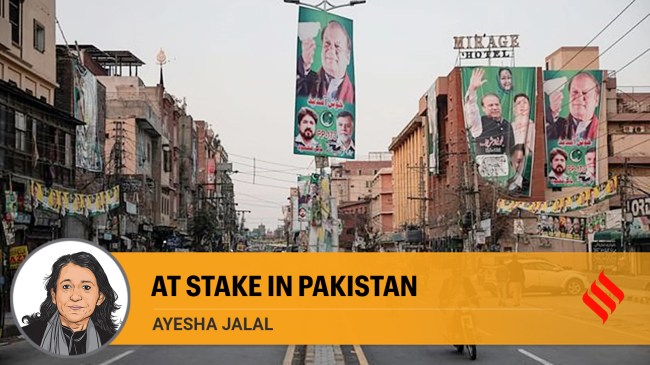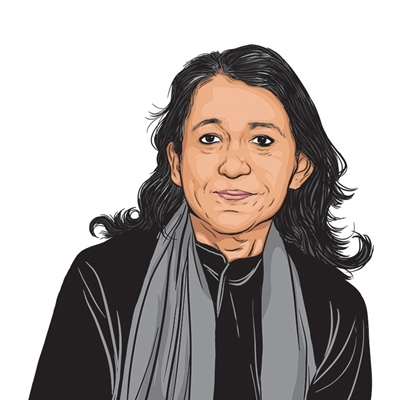Opinion Ayesha Jalal writes | Pakistan votes: Here’s what’s at stake in the elections
Challenges facing the economy are daunting and will require bold decisions structural reforms
 People commute on a street filled with campaign banners and posters of a political party, ahead of the general elections, in Lahore. (Reuters)
People commute on a street filled with campaign banners and posters of a political party, ahead of the general elections, in Lahore. (Reuters) Despite continuous rumours about a delay in the elections, security breaches, and charges of pre-electoral rigging, Pakistan is headed for the polls on February 8. Held against the backdrop of a systemic economic crisis, deepening political polarisation, and the grim aftermath of an unprecedented attack on the most powerful institution of state by a key political party on May 9, 2023, the 2024 elections are extremely important in determining Pakistan’s immediate and future trajectory. While there is every reason to be concerned about charges of unfair treatment being meted out to one party — Imran Khan’s Pakistan Tehreek-i-Insaaf (PTI) — accusations of this kind are not altogether new. In fact, all polls for the past 75 years with the exception of 1970 and to some extent 2008 and 2013 have been mired in controversy and regrets about the absence of an even playing field for all contenders.
The handover of power from one civilian government to another in 2013 had been significant but could not be sustained. The role of the higher judiciary in overthrowing Nawaz Sharif with the backing of the military in 2017 pushed democracy off the rails once again in Pakistan. The 2018 elections that anointed Imran Khan as prime minister were completely choreographed by the establishment. The current elections are also being held under close coordination with non-elected institutions of the state that have been dominant in Pakistan since the 1950s. Yet, however compromised, the electoral process is necessary constitutionally and better than an outright military takeover and some new-fangled variant of martial rule.
Now that its decades-long project of grooming and then installing Imran Khan and his party PTI into power in 2018 has failed miserably, the establishment — as the army high command is called — has to let parties that were demonised and persecuted at its behest try their luck at the hustings. While some see the Pakistan Muslim League-N (PML-N) as the new favourites of the establishment, this is simply because there is no other party that can command enough votes to govern the country’s biggest province, Punjab. This does not mean that other parties like the Pakistan People’s Party (PPP) are not trying to take advantage of the PTI’s predicament to surge ahead. But the PPP has hardly any presence in Punjab, which leaves the PML-N as the main contender against a PTI in complete disarray with its leader and top leadership languishing in jail on various charges, including treason.
The consensus is that given the multiple crises facing Pakistan today, the elections cannot be expected to be completely free and fair. But there is still hope that everything will be done to ensure that all contenders are given a chance to make their case to the electorate and that the results will be as credible as they can be under very straitened circumstances.
There is no question that demographic changes could throw up surprises, especially if the turnout is high and women as well as youth come out to vote in large numbers. If they do, the PTI is expected to benefit. But with its electoral symbol taken away and several candidates claiming to represent the party in different constituencies, it remains to be seen how well it will actually perform.
The PPP is unlikely to sway voters in Punjab as it has done precious little groundwork in Pakistan’s largest province. So, despite a vigorous campaign by Bilawal Bhutto Zardari, who is contesting from a constituency in Lahore, the PPP’s success will most likely be confined to Sindh even if it picks up more seats in Punjab than in the 2013 and 2018 elections.
The challenges facing the national economy are daunting for any party and will require bold decisions so that structural reforms are instituted to stretch the unacceptably limited tax base, improve productivity and promote exports. Going by the past record, most in Punjab believe that the PML-N is best placed to manage the country’s economy. But this is by no means the view in other provinces with the PTI holding its ground in Khyber Pakhtunkhwa and the PPP in Sindh.
All parties make grandiose promises to voters during election campaigns based on some variant of welfarism, but are typically unable to carry them out once at the helm. While large promises are being heard everywhere, no one expects much to change and the best that is being hoped for is some modicum of political stability and judicious economic decision-making to pull the country out of the current quagmire.
All parties in the fray in Pakistan also claim to want to improve relations with India and the US. But improved foreign relations depend on both sides making the necessary moves to restore trust and confidence. As things stand today, not much can be hoped by way of improved Indo-Pakistan relations. As for US-Pakistan relations, Washington’s tilt towards New Delhi is now too evident to give much hope to an incumbent government in Islamabad for any dramatic shift in relations to take place.
The writer is the Mary Richardson Professor of History at Tufts University






